Commercial Project Negotiation Presentation and Written Assessment
VerifiedAdded on 2024/05/14
|14
|2492
|83
Report
AI Summary
This report provides a detailed analysis of commercial project negotiation, focusing on contract arrangements relevant to managed services, ICT, and build agreements within organizations like Buckeridge Group of Companies and Queensland Health Department. It examines diverse government and non-government project contractual arrangements, highlighting the Australian Standards (AS) and other standard forms used in the construction sector. The report also analyzes common arguments and influence factors related to conflicting stakeholder agendas, emphasizing the importance of effective communication and stakeholder relationship management. Furthermore, it differentiates methods of project negotiation, conflict management, and stakeholder engagement across projects with differing technology standards and asset lifecycles, including distributive and integrative negotiation methods, conflict resolution strategies like confronting, compromising, smoothing, forcing, and avoiding, and key factors for effective stakeholder management. This assignment is available on Desklib, a platform offering a wide array of study resources for students.
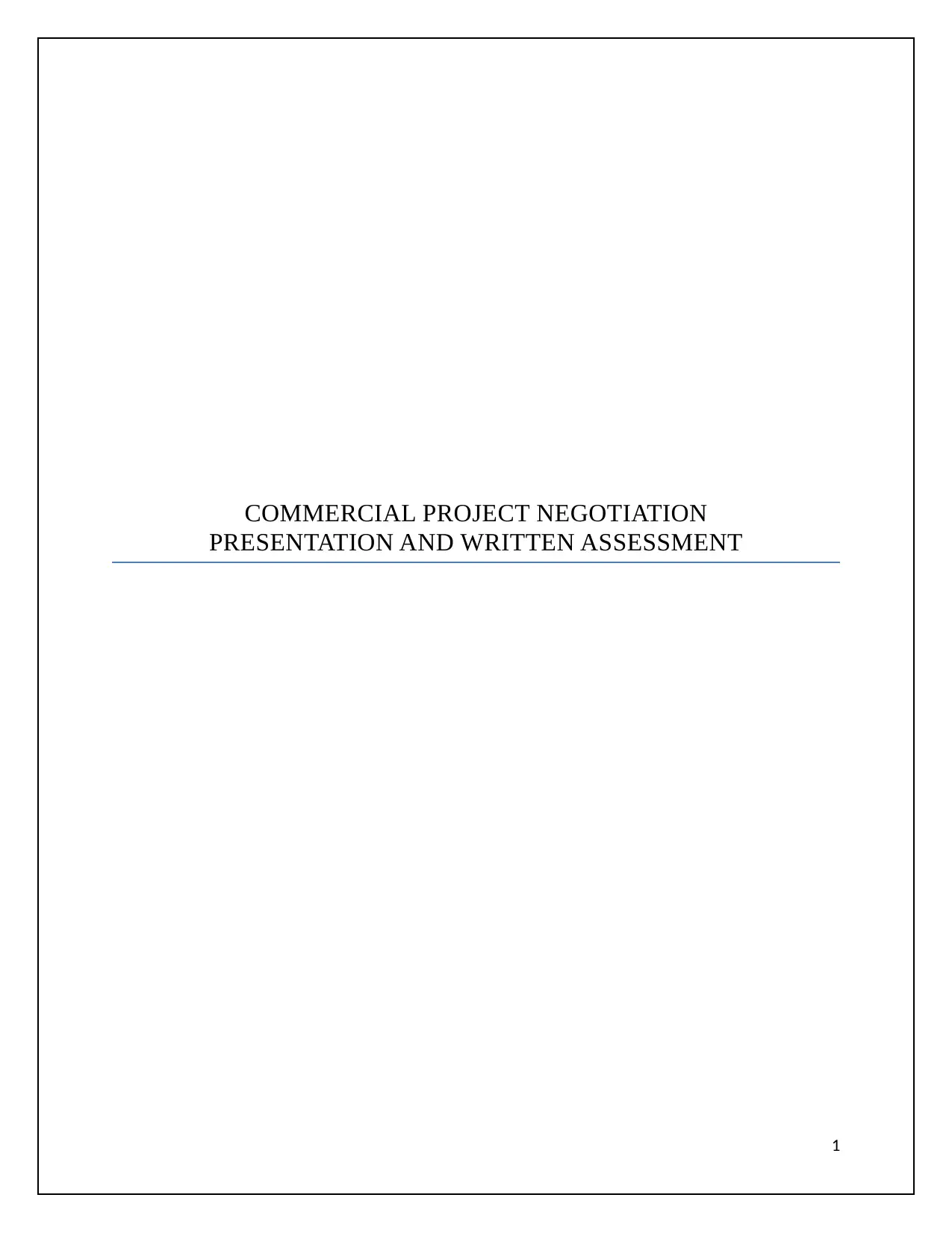
COMMERCIAL PROJECT NEGOTIATION
PRESENTATION AND WRITTEN ASSESSMENT
1
PRESENTATION AND WRITTEN ASSESSMENT
1
Paraphrase This Document
Need a fresh take? Get an instant paraphrase of this document with our AI Paraphraser
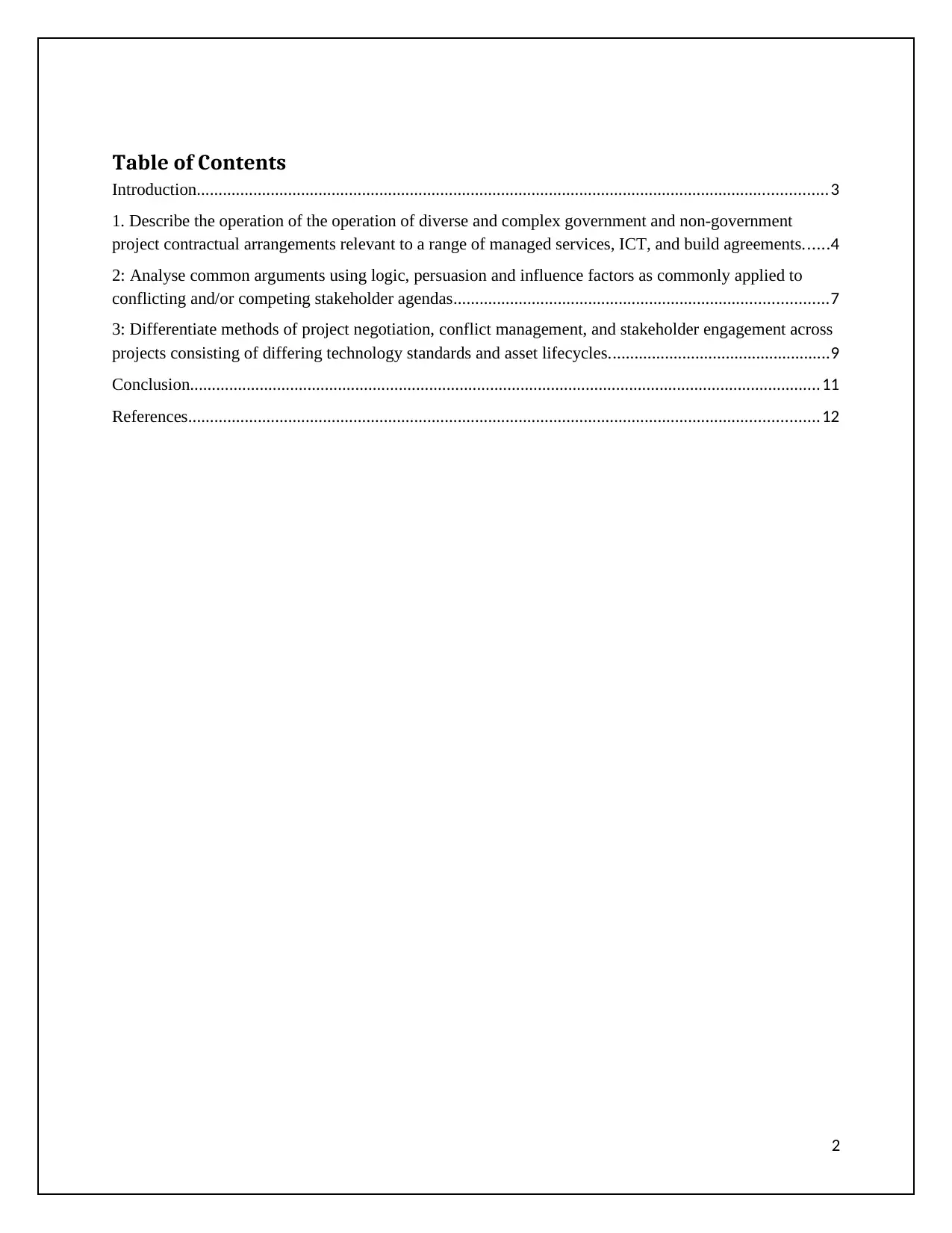
Table of Contents
Introduction.................................................................................................................................................3
1. Describe the operation of the operation of diverse and complex government and non-government
project contractual arrangements relevant to a range of managed services, ICT, and build agreements......4
2: Analyse common arguments using logic, persuasion and influence factors as commonly applied to
conflicting and/or competing stakeholder agendas......................................................................................7
3: Differentiate methods of project negotiation, conflict management, and stakeholder engagement across
projects consisting of differing technology standards and asset lifecycles...................................................9
Conclusion.................................................................................................................................................11
References.................................................................................................................................................12
2
Introduction.................................................................................................................................................3
1. Describe the operation of the operation of diverse and complex government and non-government
project contractual arrangements relevant to a range of managed services, ICT, and build agreements......4
2: Analyse common arguments using logic, persuasion and influence factors as commonly applied to
conflicting and/or competing stakeholder agendas......................................................................................7
3: Differentiate methods of project negotiation, conflict management, and stakeholder engagement across
projects consisting of differing technology standards and asset lifecycles...................................................9
Conclusion.................................................................................................................................................11
References.................................................................................................................................................12
2
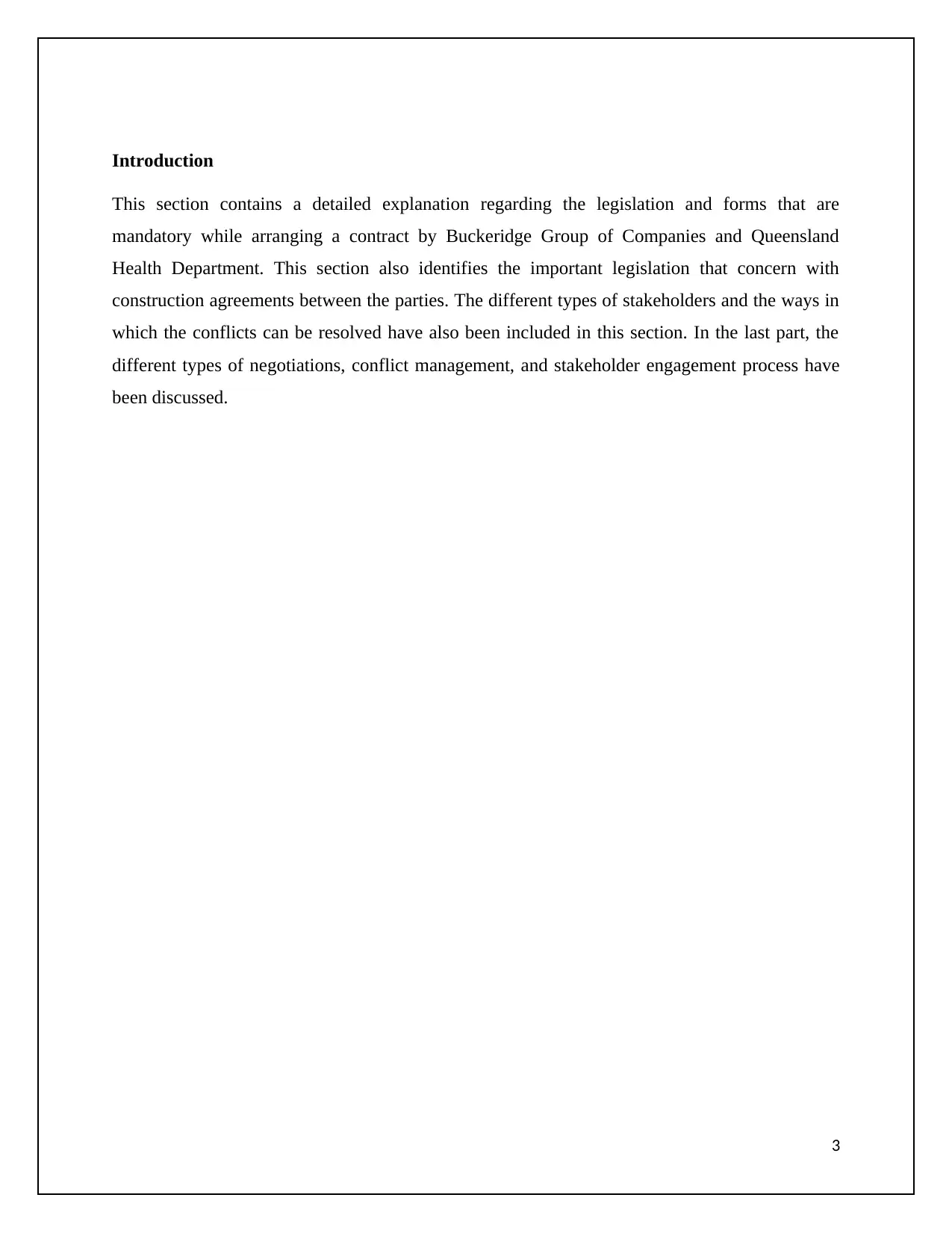
Introduction
This section contains a detailed explanation regarding the legislation and forms that are
mandatory while arranging a contract by Buckeridge Group of Companies and Queensland
Health Department. This section also identifies the important legislation that concern with
construction agreements between the parties. The different types of stakeholders and the ways in
which the conflicts can be resolved have also been included in this section. In the last part, the
different types of negotiations, conflict management, and stakeholder engagement process have
been discussed.
3
This section contains a detailed explanation regarding the legislation and forms that are
mandatory while arranging a contract by Buckeridge Group of Companies and Queensland
Health Department. This section also identifies the important legislation that concern with
construction agreements between the parties. The different types of stakeholders and the ways in
which the conflicts can be resolved have also been included in this section. In the last part, the
different types of negotiations, conflict management, and stakeholder engagement process have
been discussed.
3
⊘ This is a preview!⊘
Do you want full access?
Subscribe today to unlock all pages.

Trusted by 1+ million students worldwide
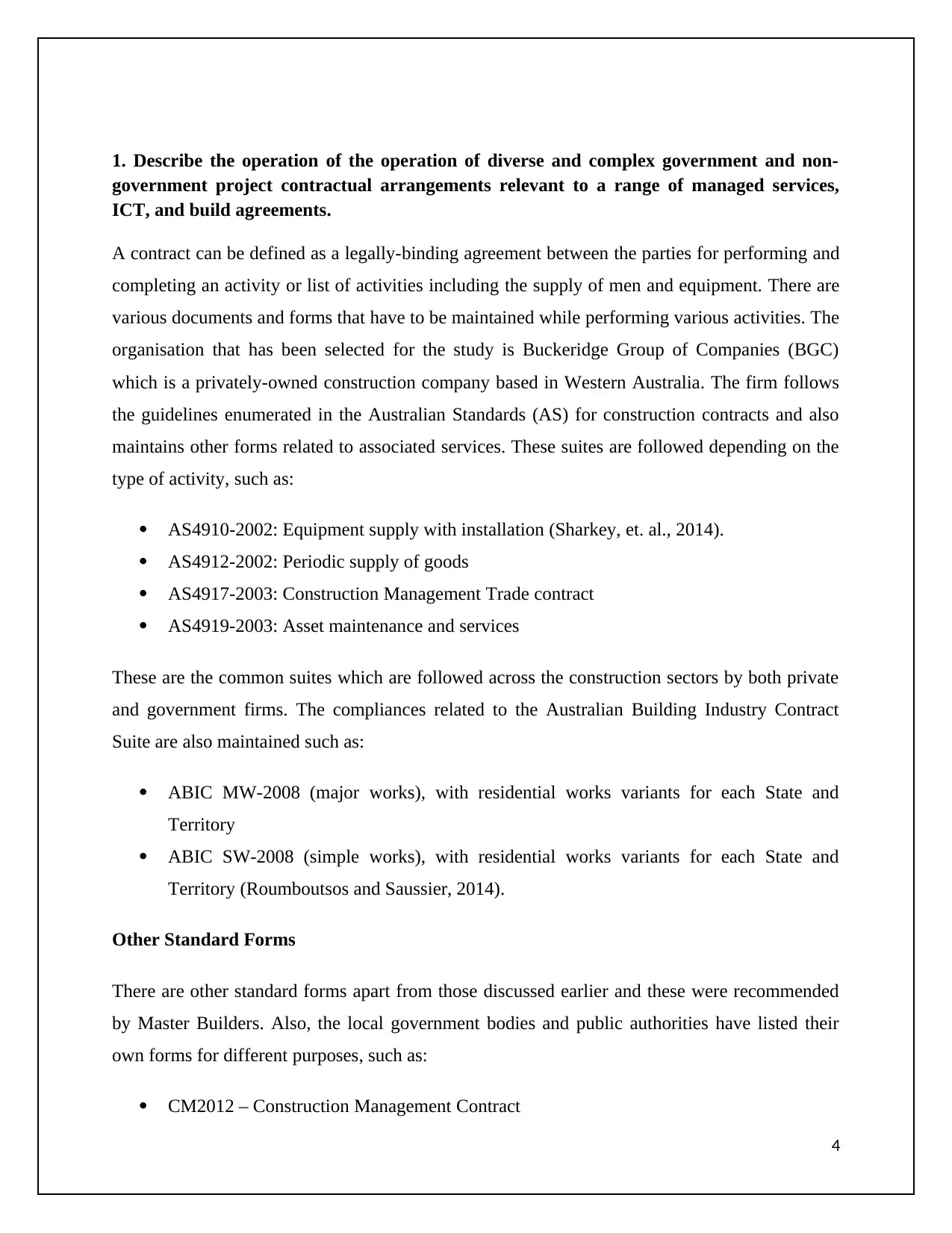
1. Describe the operation of the operation of diverse and complex government and non-
government project contractual arrangements relevant to a range of managed services,
ICT, and build agreements.
A contract can be defined as a legally-binding agreement between the parties for performing and
completing an activity or list of activities including the supply of men and equipment. There are
various documents and forms that have to be maintained while performing various activities. The
organisation that has been selected for the study is Buckeridge Group of Companies (BGC)
which is a privately-owned construction company based in Western Australia. The firm follows
the guidelines enumerated in the Australian Standards (AS) for construction contracts and also
maintains other forms related to associated services. These suites are followed depending on the
type of activity, such as:
AS4910-2002: Equipment supply with installation (Sharkey, et. al., 2014).
AS4912-2002: Periodic supply of goods
AS4917-2003: Construction Management Trade contract
AS4919-2003: Asset maintenance and services
These are the common suites which are followed across the construction sectors by both private
and government firms. The compliances related to the Australian Building Industry Contract
Suite are also maintained such as:
ABIC MW-2008 (major works), with residential works variants for each State and
Territory
ABIC SW-2008 (simple works), with residential works variants for each State and
Territory (Roumboutsos and Saussier, 2014).
Other Standard Forms
There are other standard forms apart from those discussed earlier and these were recommended
by Master Builders. Also, the local government bodies and public authorities have listed their
own forms for different purposes, such as:
CM2012 – Construction Management Contract
4
government project contractual arrangements relevant to a range of managed services,
ICT, and build agreements.
A contract can be defined as a legally-binding agreement between the parties for performing and
completing an activity or list of activities including the supply of men and equipment. There are
various documents and forms that have to be maintained while performing various activities. The
organisation that has been selected for the study is Buckeridge Group of Companies (BGC)
which is a privately-owned construction company based in Western Australia. The firm follows
the guidelines enumerated in the Australian Standards (AS) for construction contracts and also
maintains other forms related to associated services. These suites are followed depending on the
type of activity, such as:
AS4910-2002: Equipment supply with installation (Sharkey, et. al., 2014).
AS4912-2002: Periodic supply of goods
AS4917-2003: Construction Management Trade contract
AS4919-2003: Asset maintenance and services
These are the common suites which are followed across the construction sectors by both private
and government firms. The compliances related to the Australian Building Industry Contract
Suite are also maintained such as:
ABIC MW-2008 (major works), with residential works variants for each State and
Territory
ABIC SW-2008 (simple works), with residential works variants for each State and
Territory (Roumboutsos and Saussier, 2014).
Other Standard Forms
There are other standard forms apart from those discussed earlier and these were recommended
by Master Builders. Also, the local government bodies and public authorities have listed their
own forms for different purposes, such as:
CM2012 – Construction Management Contract
4
Paraphrase This Document
Need a fresh take? Get an instant paraphrase of this document with our AI Paraphraser
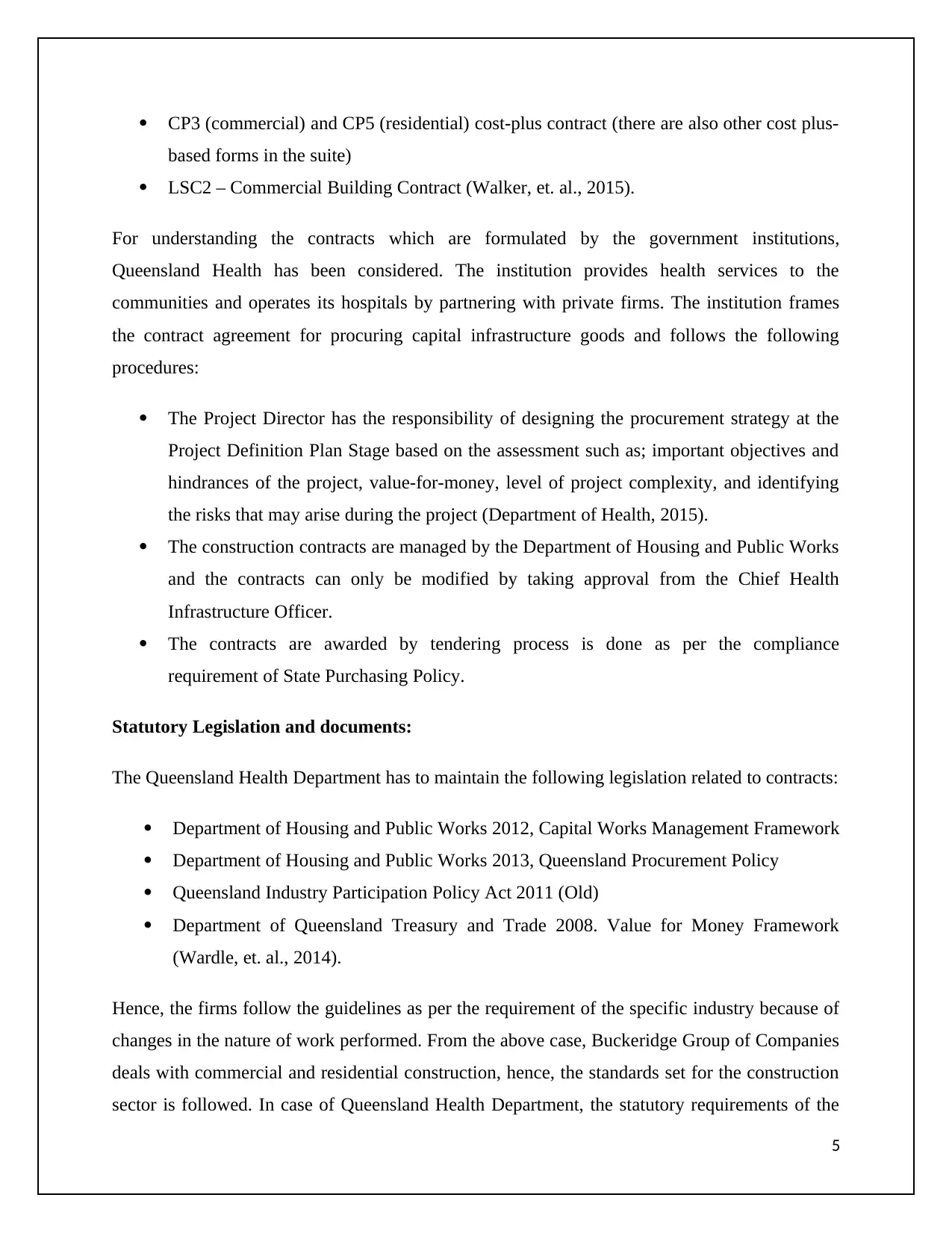
CP3 (commercial) and CP5 (residential) cost-plus contract (there are also other cost plus-
based forms in the suite)
LSC2 – Commercial Building Contract (Walker, et. al., 2015).
For understanding the contracts which are formulated by the government institutions,
Queensland Health has been considered. The institution provides health services to the
communities and operates its hospitals by partnering with private firms. The institution frames
the contract agreement for procuring capital infrastructure goods and follows the following
procedures:
The Project Director has the responsibility of designing the procurement strategy at the
Project Definition Plan Stage based on the assessment such as; important objectives and
hindrances of the project, value-for-money, level of project complexity, and identifying
the risks that may arise during the project (Department of Health, 2015).
The construction contracts are managed by the Department of Housing and Public Works
and the contracts can only be modified by taking approval from the Chief Health
Infrastructure Officer.
The contracts are awarded by tendering process is done as per the compliance
requirement of State Purchasing Policy.
Statutory Legislation and documents:
The Queensland Health Department has to maintain the following legislation related to contracts:
Department of Housing and Public Works 2012, Capital Works Management Framework
Department of Housing and Public Works 2013, Queensland Procurement Policy
Queensland Industry Participation Policy Act 2011 (Old)
Department of Queensland Treasury and Trade 2008. Value for Money Framework
(Wardle, et. al., 2014).
Hence, the firms follow the guidelines as per the requirement of the specific industry because of
changes in the nature of work performed. From the above case, Buckeridge Group of Companies
deals with commercial and residential construction, hence, the standards set for the construction
sector is followed. In case of Queensland Health Department, the statutory requirements of the
5
based forms in the suite)
LSC2 – Commercial Building Contract (Walker, et. al., 2015).
For understanding the contracts which are formulated by the government institutions,
Queensland Health has been considered. The institution provides health services to the
communities and operates its hospitals by partnering with private firms. The institution frames
the contract agreement for procuring capital infrastructure goods and follows the following
procedures:
The Project Director has the responsibility of designing the procurement strategy at the
Project Definition Plan Stage based on the assessment such as; important objectives and
hindrances of the project, value-for-money, level of project complexity, and identifying
the risks that may arise during the project (Department of Health, 2015).
The construction contracts are managed by the Department of Housing and Public Works
and the contracts can only be modified by taking approval from the Chief Health
Infrastructure Officer.
The contracts are awarded by tendering process is done as per the compliance
requirement of State Purchasing Policy.
Statutory Legislation and documents:
The Queensland Health Department has to maintain the following legislation related to contracts:
Department of Housing and Public Works 2012, Capital Works Management Framework
Department of Housing and Public Works 2013, Queensland Procurement Policy
Queensland Industry Participation Policy Act 2011 (Old)
Department of Queensland Treasury and Trade 2008. Value for Money Framework
(Wardle, et. al., 2014).
Hence, the firms follow the guidelines as per the requirement of the specific industry because of
changes in the nature of work performed. From the above case, Buckeridge Group of Companies
deals with commercial and residential construction, hence, the standards set for the construction
sector is followed. In case of Queensland Health Department, the statutory requirements of the
5
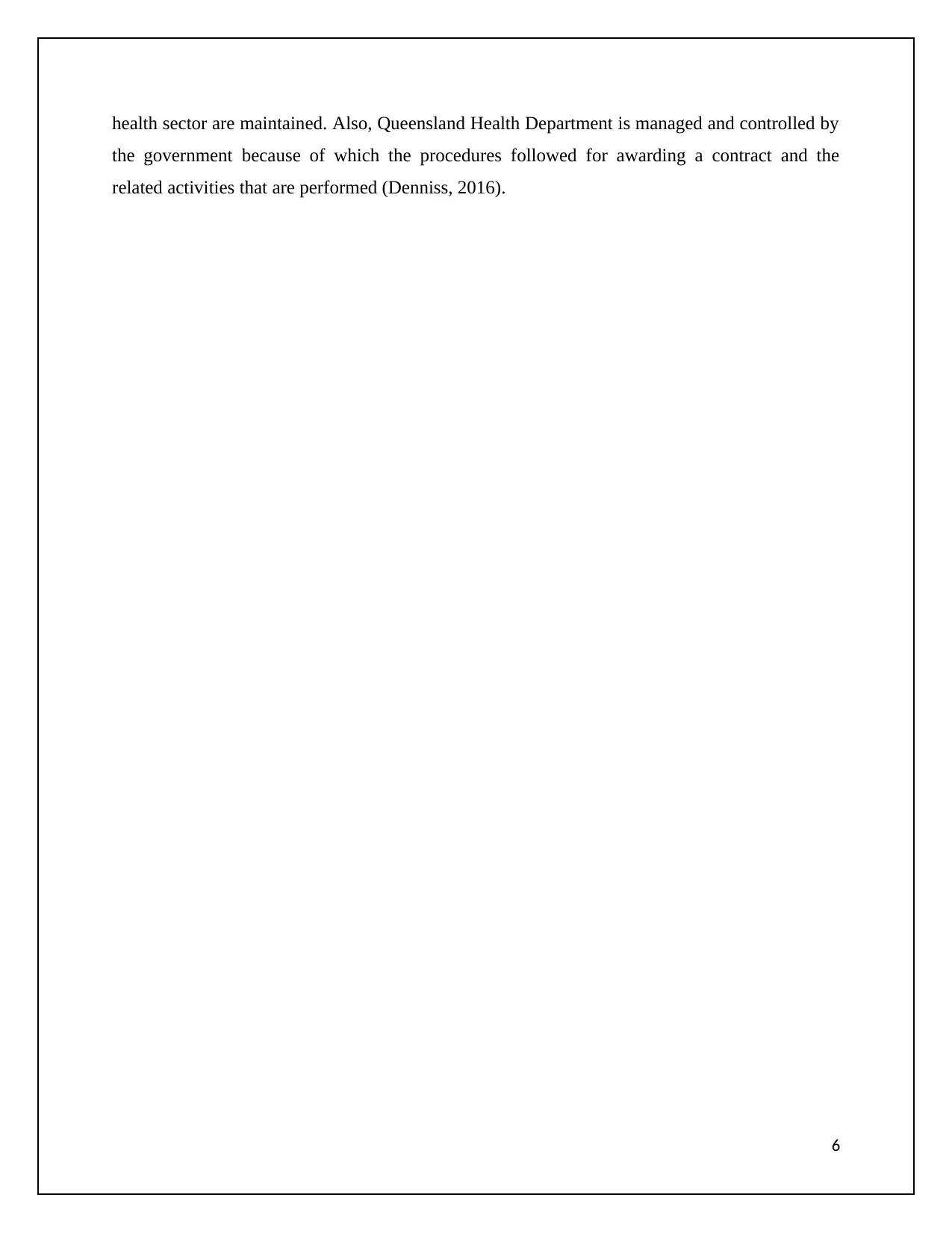
health sector are maintained. Also, Queensland Health Department is managed and controlled by
the government because of which the procedures followed for awarding a contract and the
related activities that are performed (Denniss, 2016).
6
the government because of which the procedures followed for awarding a contract and the
related activities that are performed (Denniss, 2016).
6
⊘ This is a preview!⊘
Do you want full access?
Subscribe today to unlock all pages.

Trusted by 1+ million students worldwide
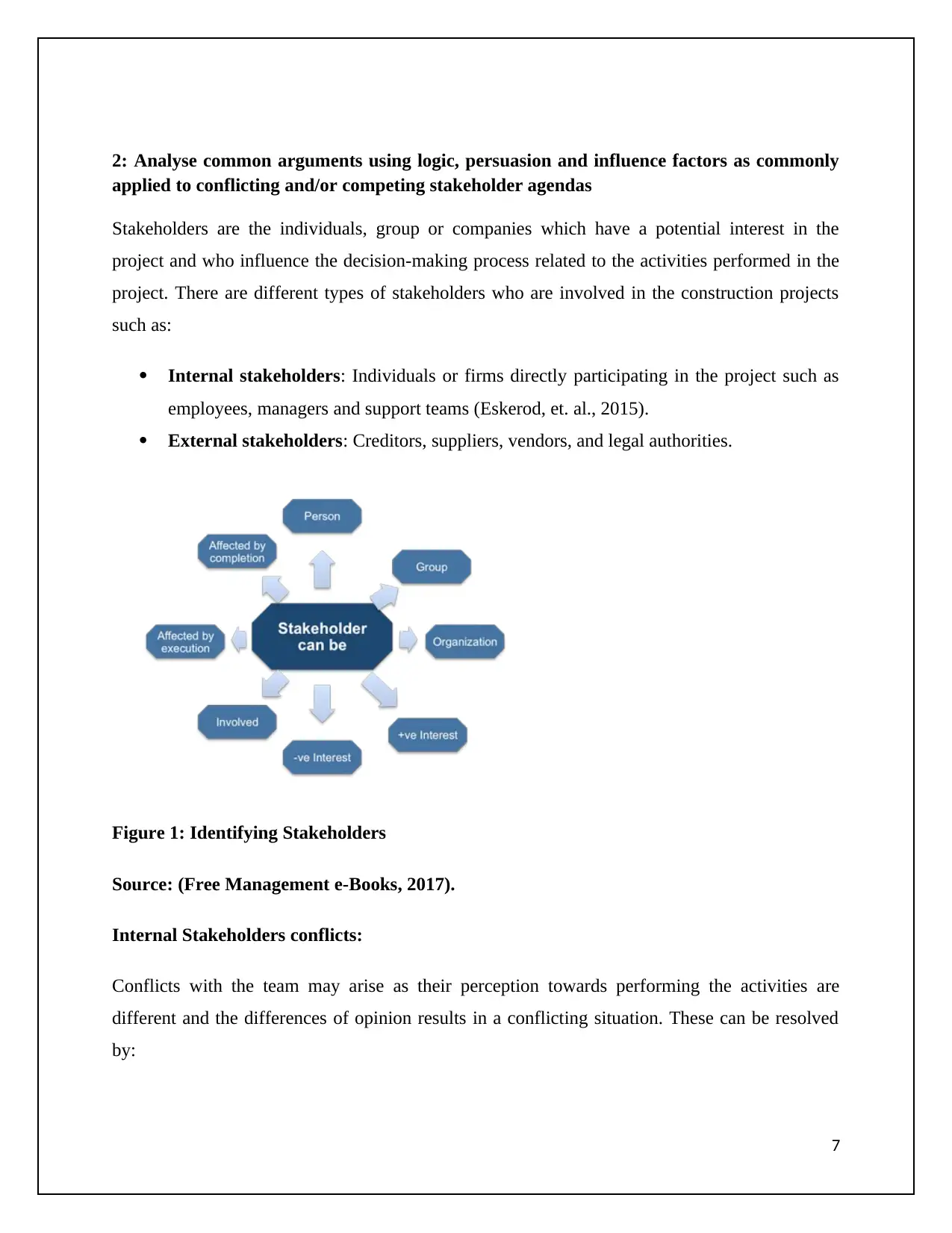
2: Analyse common arguments using logic, persuasion and influence factors as commonly
applied to conflicting and/or competing stakeholder agendas
Stakeholders are the individuals, group or companies which have a potential interest in the
project and who influence the decision-making process related to the activities performed in the
project. There are different types of stakeholders who are involved in the construction projects
such as:
Internal stakeholders: Individuals or firms directly participating in the project such as
employees, managers and support teams (Eskerod, et. al., 2015).
External stakeholders: Creditors, suppliers, vendors, and legal authorities.
Figure 1: Identifying Stakeholders
Source: (Free Management e-Books, 2017).
Internal Stakeholders conflicts:
Conflicts with the team may arise as their perception towards performing the activities are
different and the differences of opinion results in a conflicting situation. These can be resolved
by:
7
applied to conflicting and/or competing stakeholder agendas
Stakeholders are the individuals, group or companies which have a potential interest in the
project and who influence the decision-making process related to the activities performed in the
project. There are different types of stakeholders who are involved in the construction projects
such as:
Internal stakeholders: Individuals or firms directly participating in the project such as
employees, managers and support teams (Eskerod, et. al., 2015).
External stakeholders: Creditors, suppliers, vendors, and legal authorities.
Figure 1: Identifying Stakeholders
Source: (Free Management e-Books, 2017).
Internal Stakeholders conflicts:
Conflicts with the team may arise as their perception towards performing the activities are
different and the differences of opinion results in a conflicting situation. These can be resolved
by:
7
Paraphrase This Document
Need a fresh take? Get an instant paraphrase of this document with our AI Paraphraser
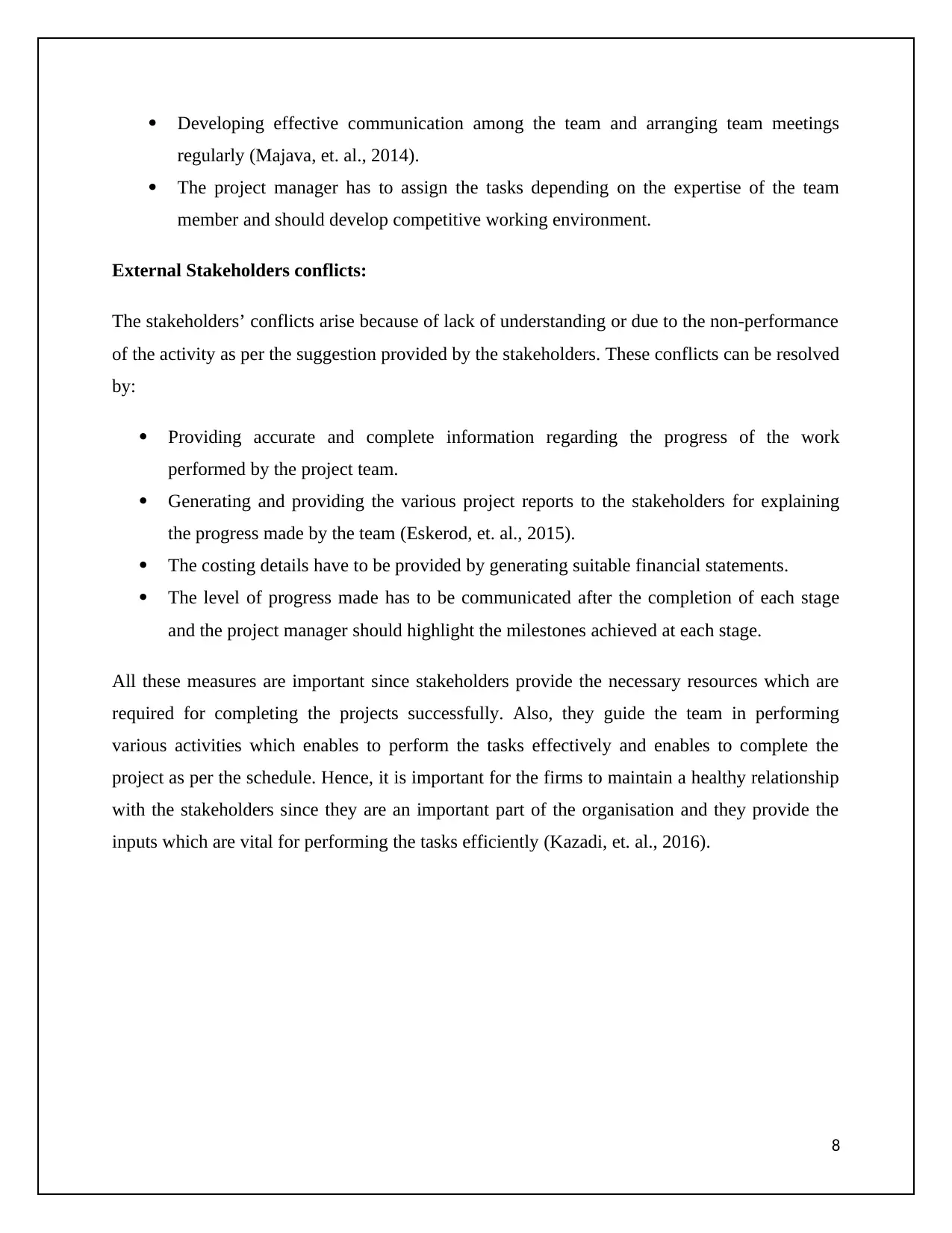
Developing effective communication among the team and arranging team meetings
regularly (Majava, et. al., 2014).
The project manager has to assign the tasks depending on the expertise of the team
member and should develop competitive working environment.
External Stakeholders conflicts:
The stakeholders’ conflicts arise because of lack of understanding or due to the non-performance
of the activity as per the suggestion provided by the stakeholders. These conflicts can be resolved
by:
Providing accurate and complete information regarding the progress of the work
performed by the project team.
Generating and providing the various project reports to the stakeholders for explaining
the progress made by the team (Eskerod, et. al., 2015).
The costing details have to be provided by generating suitable financial statements.
The level of progress made has to be communicated after the completion of each stage
and the project manager should highlight the milestones achieved at each stage.
All these measures are important since stakeholders provide the necessary resources which are
required for completing the projects successfully. Also, they guide the team in performing
various activities which enables to perform the tasks effectively and enables to complete the
project as per the schedule. Hence, it is important for the firms to maintain a healthy relationship
with the stakeholders since they are an important part of the organisation and they provide the
inputs which are vital for performing the tasks efficiently (Kazadi, et. al., 2016).
8
regularly (Majava, et. al., 2014).
The project manager has to assign the tasks depending on the expertise of the team
member and should develop competitive working environment.
External Stakeholders conflicts:
The stakeholders’ conflicts arise because of lack of understanding or due to the non-performance
of the activity as per the suggestion provided by the stakeholders. These conflicts can be resolved
by:
Providing accurate and complete information regarding the progress of the work
performed by the project team.
Generating and providing the various project reports to the stakeholders for explaining
the progress made by the team (Eskerod, et. al., 2015).
The costing details have to be provided by generating suitable financial statements.
The level of progress made has to be communicated after the completion of each stage
and the project manager should highlight the milestones achieved at each stage.
All these measures are important since stakeholders provide the necessary resources which are
required for completing the projects successfully. Also, they guide the team in performing
various activities which enables to perform the tasks effectively and enables to complete the
project as per the schedule. Hence, it is important for the firms to maintain a healthy relationship
with the stakeholders since they are an important part of the organisation and they provide the
inputs which are vital for performing the tasks efficiently (Kazadi, et. al., 2016).
8
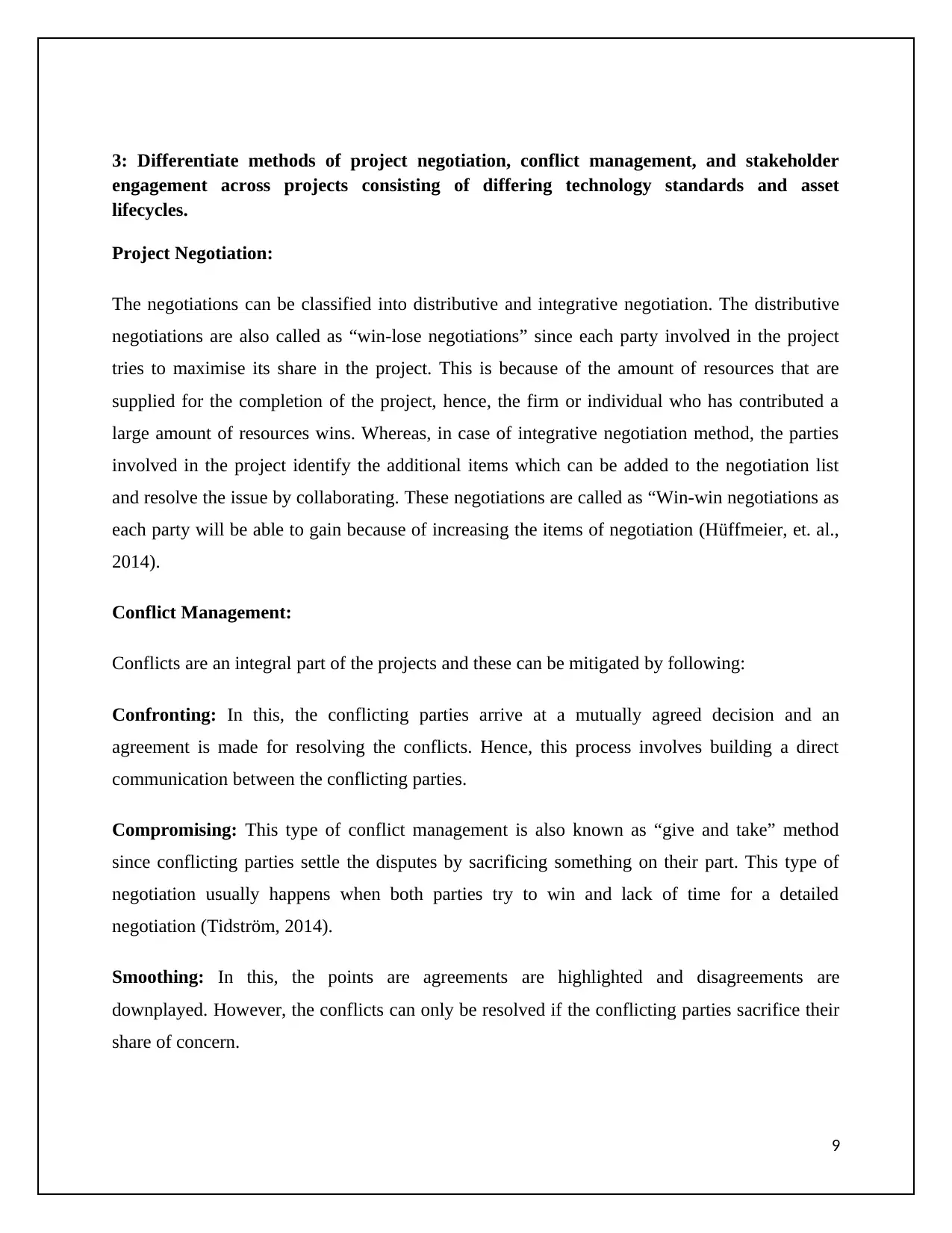
3: Differentiate methods of project negotiation, conflict management, and stakeholder
engagement across projects consisting of differing technology standards and asset
lifecycles.
Project Negotiation:
The negotiations can be classified into distributive and integrative negotiation. The distributive
negotiations are also called as “win-lose negotiations” since each party involved in the project
tries to maximise its share in the project. This is because of the amount of resources that are
supplied for the completion of the project, hence, the firm or individual who has contributed a
large amount of resources wins. Whereas, in case of integrative negotiation method, the parties
involved in the project identify the additional items which can be added to the negotiation list
and resolve the issue by collaborating. These negotiations are called as “Win-win negotiations as
each party will be able to gain because of increasing the items of negotiation (Hüffmeier, et. al.,
2014).
Conflict Management:
Conflicts are an integral part of the projects and these can be mitigated by following:
Confronting: In this, the conflicting parties arrive at a mutually agreed decision and an
agreement is made for resolving the conflicts. Hence, this process involves building a direct
communication between the conflicting parties.
Compromising: This type of conflict management is also known as “give and take” method
since conflicting parties settle the disputes by sacrificing something on their part. This type of
negotiation usually happens when both parties try to win and lack of time for a detailed
negotiation (Tidström, 2014).
Smoothing: In this, the points are agreements are highlighted and disagreements are
downplayed. However, the conflicts can only be resolved if the conflicting parties sacrifice their
share of concern.
9
engagement across projects consisting of differing technology standards and asset
lifecycles.
Project Negotiation:
The negotiations can be classified into distributive and integrative negotiation. The distributive
negotiations are also called as “win-lose negotiations” since each party involved in the project
tries to maximise its share in the project. This is because of the amount of resources that are
supplied for the completion of the project, hence, the firm or individual who has contributed a
large amount of resources wins. Whereas, in case of integrative negotiation method, the parties
involved in the project identify the additional items which can be added to the negotiation list
and resolve the issue by collaborating. These negotiations are called as “Win-win negotiations as
each party will be able to gain because of increasing the items of negotiation (Hüffmeier, et. al.,
2014).
Conflict Management:
Conflicts are an integral part of the projects and these can be mitigated by following:
Confronting: In this, the conflicting parties arrive at a mutually agreed decision and an
agreement is made for resolving the conflicts. Hence, this process involves building a direct
communication between the conflicting parties.
Compromising: This type of conflict management is also known as “give and take” method
since conflicting parties settle the disputes by sacrificing something on their part. This type of
negotiation usually happens when both parties try to win and lack of time for a detailed
negotiation (Tidström, 2014).
Smoothing: In this, the points are agreements are highlighted and disagreements are
downplayed. However, the conflicts can only be resolved if the conflicting parties sacrifice their
share of concern.
9
⊘ This is a preview!⊘
Do you want full access?
Subscribe today to unlock all pages.

Trusted by 1+ million students worldwide
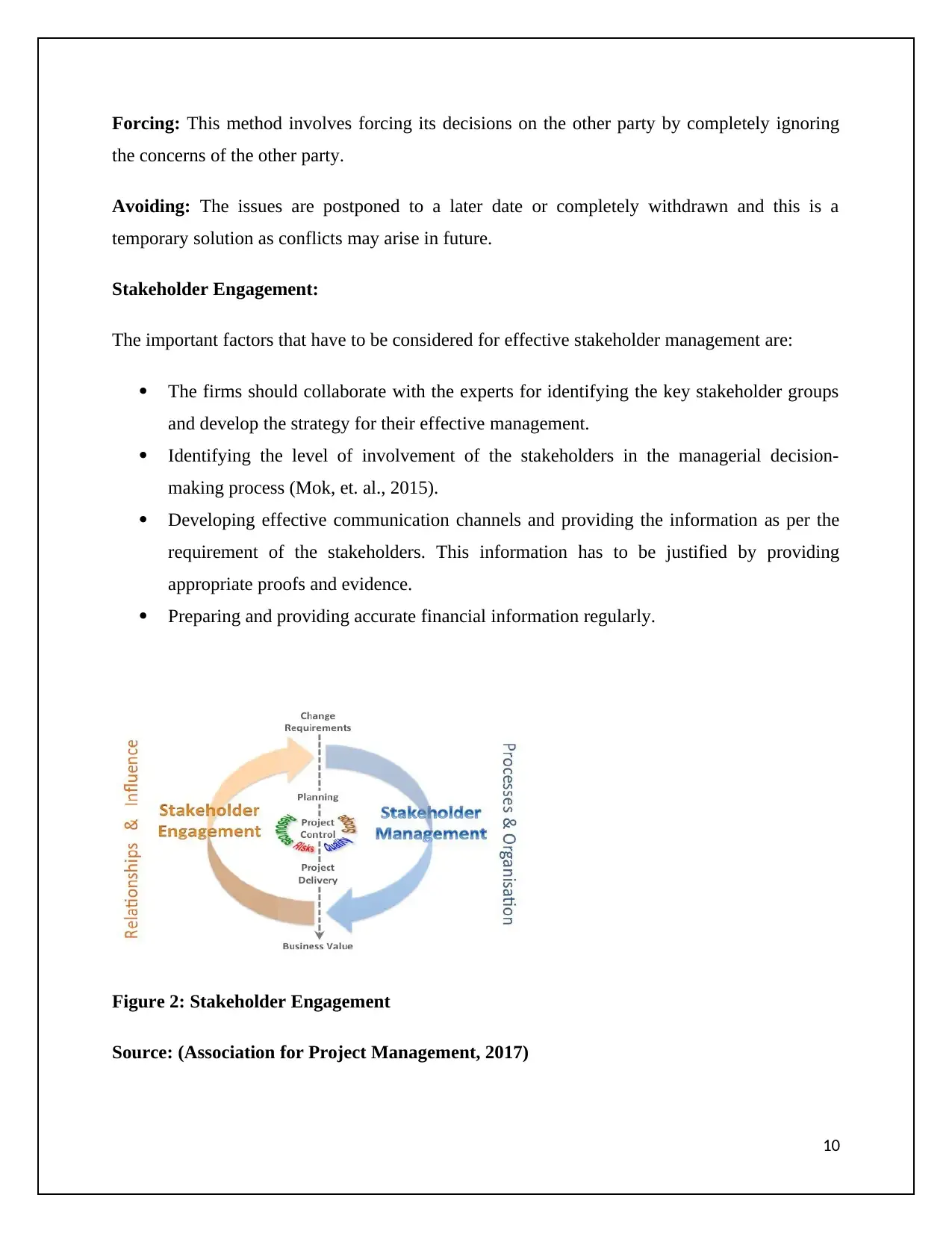
Forcing: This method involves forcing its decisions on the other party by completely ignoring
the concerns of the other party.
Avoiding: The issues are postponed to a later date or completely withdrawn and this is a
temporary solution as conflicts may arise in future.
Stakeholder Engagement:
The important factors that have to be considered for effective stakeholder management are:
The firms should collaborate with the experts for identifying the key stakeholder groups
and develop the strategy for their effective management.
Identifying the level of involvement of the stakeholders in the managerial decision-
making process (Mok, et. al., 2015).
Developing effective communication channels and providing the information as per the
requirement of the stakeholders. This information has to be justified by providing
appropriate proofs and evidence.
Preparing and providing accurate financial information regularly.
Figure 2: Stakeholder Engagement
Source: (Association for Project Management, 2017)
10
the concerns of the other party.
Avoiding: The issues are postponed to a later date or completely withdrawn and this is a
temporary solution as conflicts may arise in future.
Stakeholder Engagement:
The important factors that have to be considered for effective stakeholder management are:
The firms should collaborate with the experts for identifying the key stakeholder groups
and develop the strategy for their effective management.
Identifying the level of involvement of the stakeholders in the managerial decision-
making process (Mok, et. al., 2015).
Developing effective communication channels and providing the information as per the
requirement of the stakeholders. This information has to be justified by providing
appropriate proofs and evidence.
Preparing and providing accurate financial information regularly.
Figure 2: Stakeholder Engagement
Source: (Association for Project Management, 2017)
10
Paraphrase This Document
Need a fresh take? Get an instant paraphrase of this document with our AI Paraphraser

11
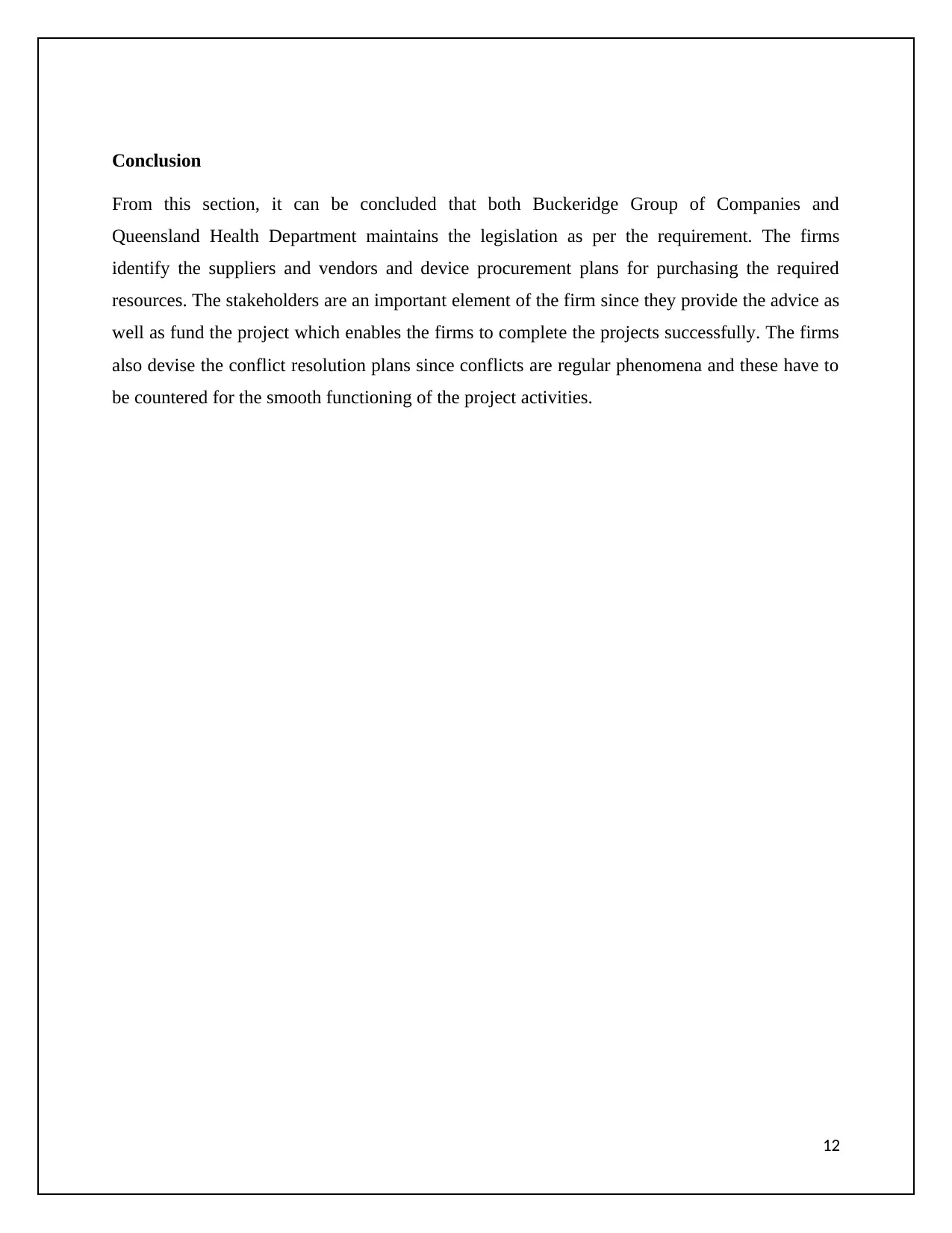
Conclusion
From this section, it can be concluded that both Buckeridge Group of Companies and
Queensland Health Department maintains the legislation as per the requirement. The firms
identify the suppliers and vendors and device procurement plans for purchasing the required
resources. The stakeholders are an important element of the firm since they provide the advice as
well as fund the project which enables the firms to complete the projects successfully. The firms
also devise the conflict resolution plans since conflicts are regular phenomena and these have to
be countered for the smooth functioning of the project activities.
12
From this section, it can be concluded that both Buckeridge Group of Companies and
Queensland Health Department maintains the legislation as per the requirement. The firms
identify the suppliers and vendors and device procurement plans for purchasing the required
resources. The stakeholders are an important element of the firm since they provide the advice as
well as fund the project which enables the firms to complete the projects successfully. The firms
also devise the conflict resolution plans since conflicts are regular phenomena and these have to
be countered for the smooth functioning of the project activities.
12
⊘ This is a preview!⊘
Do you want full access?
Subscribe today to unlock all pages.

Trusted by 1+ million students worldwide
1 out of 14
Related Documents
Your All-in-One AI-Powered Toolkit for Academic Success.
+13062052269
info@desklib.com
Available 24*7 on WhatsApp / Email
![[object Object]](/_next/static/media/star-bottom.7253800d.svg)
Unlock your academic potential
Copyright © 2020–2025 A2Z Services. All Rights Reserved. Developed and managed by ZUCOL.


